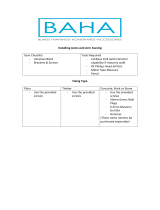Ensure that the abutment is secure and that the
area around it is clean.
Take advantage of the Patient User Manual
to review the next 4 steps, this will familiarize
the client with the manual.
Schedule a follow-up appointment.Fill in the registration card. Explain insurance
terms and warranties.
Specify which accessories are available;
discuss uses and the client’s possible needs.
Instruct the client on care and maintenance
of the abutment and abutment area.
Review troubleshooting of the sound processor.
Describe how to change the battery and
mention the expected battery life.
STEP 1
Have the patient practice connecting/disconnecting
the dummy device, first on a snap trainer, then on
his/her abutment.
STEP 4
Connect the Baha® 3 Sound Processor (BP100 or
BP110) to the Baha Fitting Software, then connect it
to the patient’s abutment. Use BC Direct to measure
the patient’s direct bone conduction thresholds.
STEP 2
Let the client connect the sound
processor and adjust the volume control
to the most comfortable level (MCL).
STEP 5 STEP 6
STEP 8
STEP 10 STEP 11 STEP 12
For more detailed information on fitting and fine tuning, see the Cochlear™ Baha Fitting Software Guide.
STEP 9
Adjust the Baha 3 Sound Processor (BP100
or BP110) based on the patient’s comments.
Let the patient reset the volume if needed.
STEP 3 Volume up and
down button
STEP 7
Explain how to use the on/off button, program
buttons and volume control and how to care for
the sound processor.
Sound Processors Fitting Quick Guide
Baha 3 Sound
Processor (BP100) Baha 3 Power Sound
Processor (BP110)






